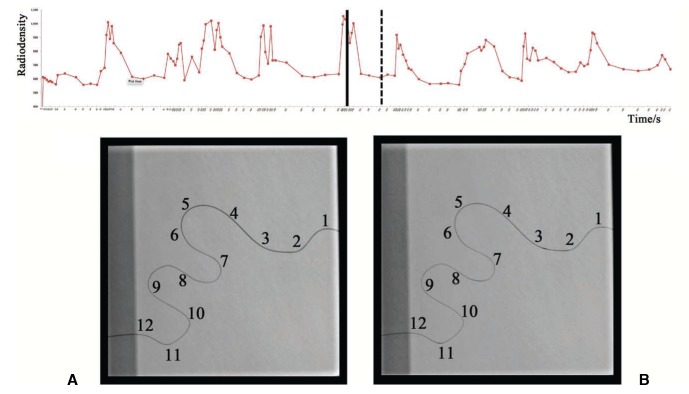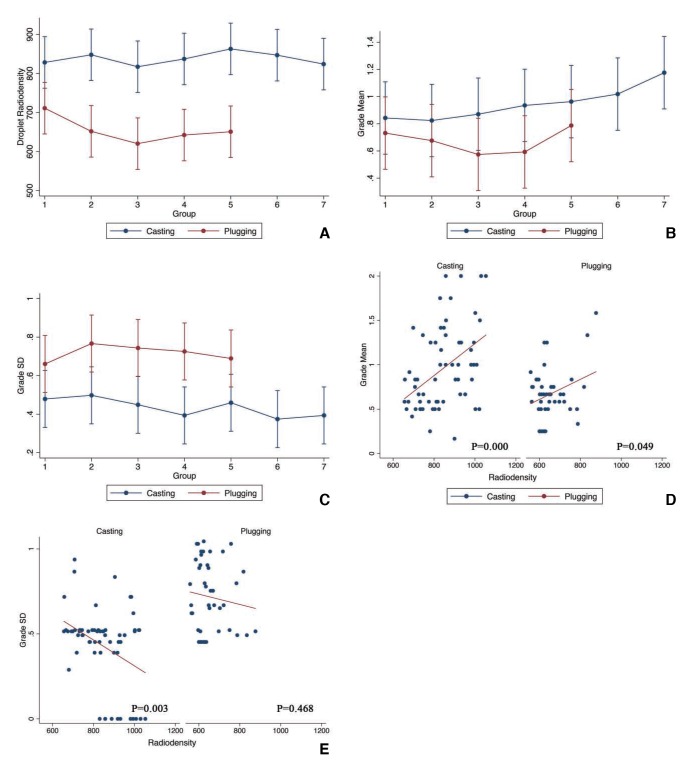Neurointervention.
2017 Mar;12(1):3-10. 10.5469/neuroint.2017.12.1.3.
In Vitro Quantification of the Radiopacity of Onyx during Embolization
- Affiliations
-
- 1Department of Medical Biotechnology, Dongguk University, Ilsan, Korea.
- 2Department of Radiology, Research Institute of Radiology, Asan Medical Center, University of Ulsan College of Medicine, Seoul, Korea. dhlee@amc.seoul.kr
- 3Biomedical R&D Center, Asan Institute for Life Sciences, Asan Medical Center, Seoul, Korea.
- 4Department of Convergence Medicine, Asan Medical Center, University of Ulsan College of Medicine, Seoul, Korea.
- KMID: 2371753
- DOI: http://doi.org/10.5469/neuroint.2017.12.1.3
Abstract
- PURPOSE
Onyx has been successfully applied in the treatment of various neurovascular lesions. However, some experience is required to get accustomed to its unpredictable fluoroscopic visibility during injection. This in vitro study aimed to evaluate the characteristics of radiopacity change in a simulated embolization procedure.
MATERIALS AND METHODS
Using a bench-top Onyx injection experiment simulating a typical brain arteriovenous malformation embolization, nine cycles of casting modes (continuous injection) and plugging modes (injection with intermittent pauses) were performed. Radiodensity of Onyx droplets collected from the microcatheter tip and the distal head portion of the microcatheter were measured as time lapsed. Distribution of droplet radiodensity (radiodensity) and distribution of radiographic grade (grade) were analyzed and compared by repeated measurements.
RESULTS
Within-group analysis revealed no significant radiodensity change with time (P>0.05). The radiodensity was significantly higher in the casting mode than in the plugging mode (P<0.01). The lateral radiograph of the microcatheter showed higher radiopacity (P<0.01) and better evenness (P<0.01) in the casting mode than in the plugging mode. A significant difference in microcatheter attenuation (both radiographic grade mean and SD; P<0.01) was noted between the two modes. Radiodensity had a significant influence on the radiopacity and radiopacity evenness of the microcatheter.
CONCLUSION
The radiopacity of the Onyx can vary significantly over time because of early precipitation of tantalum powder. Radiopacity decreased significantly during plugging modes, characterized by pauses between injections.
Figure
Reference
-
1. Katsaridis V, Papagiannaki C, Aimar E. Curative embolization of cerebral arteriovenous malformations (AVMs) with Onyx in 101 patients. Neuroradiology. 2008; 50:589–597. PMID: 18408923.
Article2. Mounayer C, Hammami N, Piotin M, Spelle L, Benndorf G, Kessler I, et al. Nidal embolization of brain arteriovenous malformations using Onyx in 94 patients. AJNR Am J Neuroradiol. 2007; 28:518–523. PMID: 17353327.3. van Rooij WJ, Jacobs S, Sluzewski M, van der Pol B, Beute GN, Sprengers ME. Curative embolization of brain arteriovenous malformations with onyx: patient selection, embolization technique, and results. AJNR Am J Neuroradiol. 2012; 33:1299–1304. PMID: 22383233.
Article4. Terada T, Nakamura Y, Nakai K, Tsuura M, Nishiguchi T, Hayashi S, et al. Embolization of arteriovenous malformations with peripheral aneurysms using ethylene vinyl alcohol copolymer. Report of three cases. J Neurosurg. 1991; 75:655–666. PMID: 1885987.5. Yamashita K, Taki W, Iwata H, Nakahara I, Nishi S, Sadato A, et al. Characteristics of ethylene vinyl alcohol copolymer (EVAL) mixtures. AJNR Am J Neuroradiol. 1994; 15:1103–1105. PMID: 8073979.6. Siekmann R. Basics and Principles in the Application of Onyx LD Liquid Embolic System in the Endovascular Treatment of Cerebral Arteriovenous Malformations. Interv Neuroradiol. 2005; 11(Suppl 1):131–140.
Article7. van Rooij WJ, Sluzewski M, Beute GN. Brain AVM embolization with Onyx. AJNR Am J Neuroradiol. 2007; 28:172–177. PMID: 17213451.8. Lv X, Wu Z, Li Y. Arteriovenous malformation in the brain: a theoretical study explaining the behavior of liquid embolic agents during endovascular treatment. Neuroradiol J. 2013; 26:661–668. PMID: 24355185.
Article9. Weber W, Kis B, Siekmann R, Kuehne D. Endovascular treatment of intracranial arteriovenous malformations with onyx: technical aspects. AJNR Am J Neuroradiol. 2007; 28:371–377. PMID: 17297015.10. Chaloupka JC, Huddle DC, Alderman J, Fink S, Hammond R, Vinters HV. A reexamination of the angiotoxicity of superselective injection of DMSO in the swine rete embolization model. AJNR Am J Neuroradiol. 1999; 20:401–410. PMID: 10219404.11. Murayama Y, Vinuela F, Ulhoa A, Akiba Y, Duckwiler GR, Gobin YP, et al. Nonadhesive liquid embolic agent for cerebral arteriovenous malformations: preliminary histopathological studies in swine rete mirabile. Neurosurgery. 1998; 43:1164–1175. PMID: 9802860.
Article12. van Beijnum J, van der Worp HB, Buis DR, Al-Shahi Salman R, Kappelle LJ, Rinkel GJ, et al. Treatment of brain arteriovenous malformations: a systematic review and meta-analysis. JAMA. 2011; 306:2011–2019. PMID: 22068993.
- Full Text Links
- Actions
-
Cited
- CITED
-
- Close
- Share
- Similar articles
-
- Complication Associated with Onyx Embolization of Spinal Cord Arteriovenous Malformation
- Hairball-Like Migration of “Onyx Threads” into the Draining Vein during Transarterial Embolization of a Dural Arteriovenous Fistula: A Case Report and Experimental Validation
- Intra-arterial Onyx Embolization of Vertebral Body Lesions
- Cranial Nerve Palsy after Onyx Embolization as a Treatment for Cerebral Vascular Malformation
- Dural Arteriovenous Fistula Involving Transverse Sinus: Successful Embolization Using Onyx(R)




